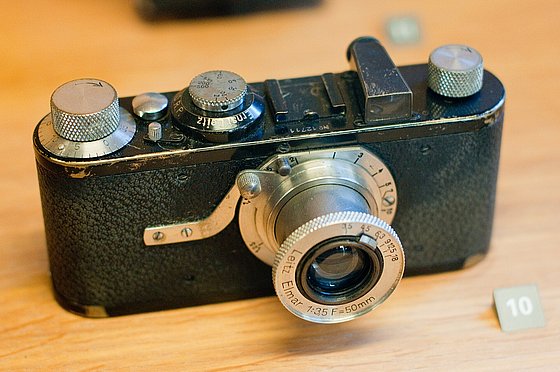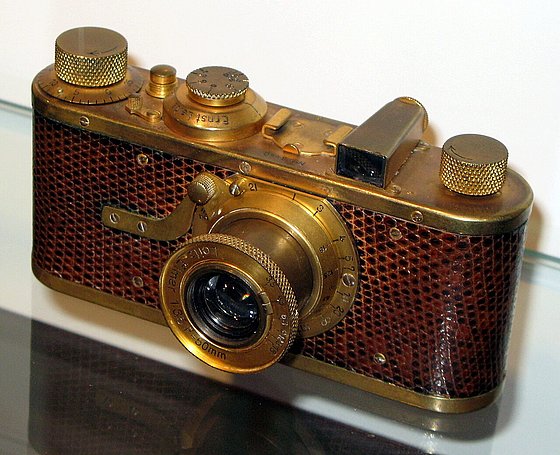
Revolution in photography - the first 35mm camera
Christoph Westermeier / Art
Photo: Westermeier
Revolution in photography
The photographer and lecturer in art, Christoph Westermeier, on the serial production of the first Leica camera
Oskar Barnack, an employee of the Ernst Leitz company, invented the so-called "Ur-Leica" in Wetzlar in 1913. That was for health reasons, so to speak, wasn't it?
Christoph Westermeier: Oskar Barnack is one of those ingenious inventors of the 19th century whose invention had a decisive influence on the photographic image in the 20th century and whose significance extends to the present day. He was born in Brandenburg in 1879, went on an apprenticeship towards the end of the century and was employed as a master mechanic by the company now known as Leica Camera AG in 1911, back in the days of the German Empire.
In his spare time, Barnack was an enthusiastic amateur photographer - and when we talk about photography at the beginning of the 20th century, we are talking about plate cameras, heavy equipment and complicated technical processes.
However, Oskar Barnack had severe asthma and suffered from lung and bronchial problems. This restricted him in his favourite hobby, photography. However, as he did not want to give up photography, he looked for a way to take photographs without great physical exertion and became the inventor of the "Ur-Leica".
Where does the name Leica come from?
Christoph Westermeier: The name has nothing to do with the world's favourite dog, Laika, but is a very mundane combination of the words "Lei" - from Leitz (the surname of company founder Ernst Leitz) and "ca" - from camera.

Leica I (A), serial number 12711 (1928); objective: Leitz Elmar 1 : 3.5 F = 50 mm
Photo: CC BY
After long discussions, the Leica I went into series production in 1925. This 35 mm camera triggered a revolution in photography. Why?
Christoph Westermeier: Until the invention of the Leica, photography was a static process. A large camera had to be set up, the exposure time was long and the process was technically complicated.
The early photographs were therefore taken from a frontal perspective, they were static and immobile. With the invention of the Leica, photography became more physical, the lines of sight changed and the view went upwards, downwards and to the side. With the spread of the Leica 100 years ago, a new chapter was opened and photography changed fundamentally.
Barnack turned the cinema image into a photographic image. What does that mean?
Christoph Westermeier : When Barnack started working at the Ernst Leitz company, film was mainly used in the cinema - in other words, as 35 mm wide cinema film that ran horizontally through the projector and on which each shot was about 18 × 24 mm in size. Barnack, however, shot this film horizontally in his camera and enlarged the image format to 24 by 36 millimetres. This enabled him to use the same film that was otherwise intended for cinema films for still images. In this way, Barnack turned the "cinema picture" into a "photo picture".
In addition to the technical ingenuity, the housing that was developed to use this new invention in everyday life is also interesting.
He had the housing cast from aluminium. The camera actually fitted into a jacket pocket. But the patent application was rejected at the time. Why was that?
Christoph Westermeier: Oskar Barnack was not the only inventor researching a new type of camera. The Imperial Patent Office, where the original Leica was to be registered, saw a patent from Carl Zeiss/Jena and a French patent in conflict. The patent's little brother, utility model protection, was therefore granted first.
Interestingly, Barnack was employed as a precision mechanic and adjuster at Carl Zeiss before his employment in Wetzlar.

Leica in luxury version
Photo: CC BY-SA 2.0 fr
The Leica I was presented at the Leipzig Spring Fair in 1925 and impressed with its compactness, easy handling and image quality. It made completely new types of photography possible for photojournalists and amateur photographers. What became possible?
Christoph Westermeier: The photographic image as we know it today was only made possible by Barnack's invention. Photojournalism that can act quickly and actively on location didn't exist before. Hobby photography was also an elitist pursuit until then and was more comparable to watercolour painting. This changed 100 years ago: photography reinvented itself. The democratisation of the image, easy access and the inclusive approach of photography are the consequences of Barnack's pioneering invention.
His invention defined the photographic image until the introduction of the digital camera. However, digital photography works very differently: instead of capturing a moment for eternity on a negative, a file is created that can be easily edited and results in AI-generated images.

Leica IIIf (1954) with self-timer,
Photo :CC BY-SA 4.0
The Leica was a financial success. But Barnack also developed this camera further, didn't he?
Christoph Westermeier: Of course. The model that was presented 100 years ago was already different from the original Leica, and it goes without saying that the Leica was adjusted and optimised from model to model, even after Barnack's death. Technical change did not stop at the company and the camera and continues to the present day.
The Leica inventor died in 1936. But his camera is a recipe for success and is still in production today. Do you also work with a Leica?
Christoph Westermeier: I work with many different cameras - and one of them is a Leica. The famous lettering still characterises the photography scene today and a living legend like my colleague Katharina Sieverding would be unthinkable without Leica.
Uwe Blass
Christoph Westermeier studied at the Kunstakademie Düsseldorf. He is a lecturer in photography in the school of art and design at the University of Wuppertal.
